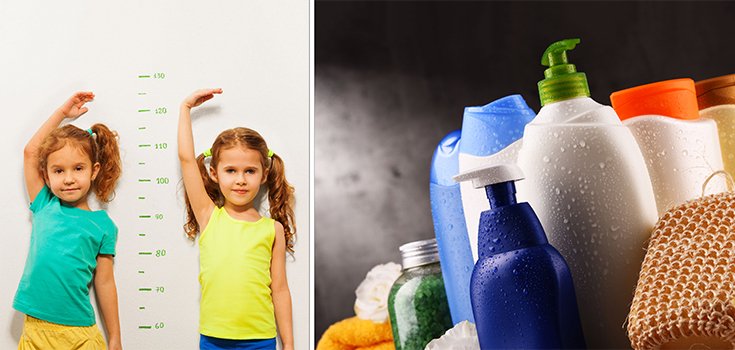Chemicals in Cosmetics, Other Products Tied to Early Puberty in Girls

It has become increasingly clear in recent years that exposure to numerous chemicals used in our daily lives can have a significant impact on human development. One recent study shows that chemicals in cosmetics and personal care products such as soaps and shampoos may push early puberty in girls. [1]
The study suggests that prenatal exposure to these chemicals is primarily to blame.
Phthalates and other chemicals have been linked to early puberty in girls in past research. These substances are found in scented products like perfumes, soaps, and shampoos. Two categories of chemicals called parabens and phenols are often used as preservatives in cosmetics. Exposure to the products are believed to interfere with sex hormones and the timing of puberty, but few studies have explored this connection in children.
Chemicals linked to early puberty are ubiquitous, however. Even toothpaste and skin lotions contain potentially-dangerous ingredients.
Study author Kim Harley explained that these chemicals:
“…get into our bodies either by absorption through the skin, by being inhaled, or being ingested [like lipstick]. Once they are in the body, they are quickly metabolized and [then] excreted in urine.” [2]
According to Harley, associate director of the Center for Environmental Research and Children’s Health at the University of California, Berkeley, the chemicals have “been shown to mimic estrogen in certain laboratory conditions.”
Her research reveals that puberty will occur earlier and earlier with increased exposure. However, Harley and her associates did not find a link between prenatal exposure to these chemicals and early puberty in boys.
Read: Age 10 the “New Norm” for Puberty in Girls Thanks to Chemicals
“We were a little surprised that the associations were only with the girls and we didn’t see much with boys. But since these tend to be estrogenic chemicals, it makes sense that they might impact girls.”
Personal Care Products May Cause Personal Harm

For the study, Harley’s team analyzed data collected in a study of pregnant women between 1999 and 2000. During their pregnancies, the women had their blood tested twice and they were interviewed to determine their level of exposures to the chemicals in question.
Nine in 10 of all urine samples collected from the pregnant women tested positive for phthalates, parabens, or phenols, though slightly fewer (7 in 10) women tested positive specifically for triclosan.
This could be because many cosmetic companies have voluntarily removed triclosan from their products, and because the chemical is now banned from antibacterial soaps and body washes, per a 2016 order by the U.S. Food and Drug Administration (FDA).
The researchers tracked 338 of the women’s children through adolescence, collecting urine samples from them once they reached age 9. Then, the team tracked the onset of puberty in the kids between the ages of 9 and 13.
Some of the Findings
- For every doubling of phthalate levels in an expectant mother’s blood, the development of her daughter’s pubic hair started 1.3 months earlier than usual.
- When a mother’s triclosan levels doubled, her daughter’s first period started 1 month earlier than usual.
- A doubling of paraben levels in girls was linked to the development of both her breasts and pubic hair 1 month earlier than usual.
- Over 90% of the children’s urine samples showed concentrations of all of the chemicals in question, except triclosan.
- Triclosan was found in 69% of the children’s urine samples.
But Harley said the findings don’t prove that chemical exposure causes early puberty in girls. [2]
“There is always the possibility that there were confounding factors that we were not able to control, or that our findings were due to chance.
That said, our findings are consistent with what we know about the endocrine-disrupting properties of these chemicals. So, although we are not ready to say that early life exposure to these chemicals causes earlier puberty in girls, we have enough evidence to be concerned.”
Read: Avoid These 5 Toxins for You and Your Child’s Health
One limitation of the study is that researchers weren’t able to tell if girls going through puberty might be more likely to use these personal care products, which could affect their personal exposure levels. [1]
Either way, exposure to these chemicals certainly isn’t a good thing, and in most cases, it’s easy to limit your exposure to these offending chemicals.
- Harley said buyers should beware of toothpastes listing triclosan in their ingredients.
- Furthermore, people should look for parabens, often listed as methyl paraben, or propyl paraben, on ingredient lists and avoid them, too.
It’s tougher to avoid diethyl phthalate, however, because it isn’t listed on labels and is often used in fragrances.
The study appears in the journal Human Reproduction.
Sources:
[1] Reuters
[2] HealthDay
